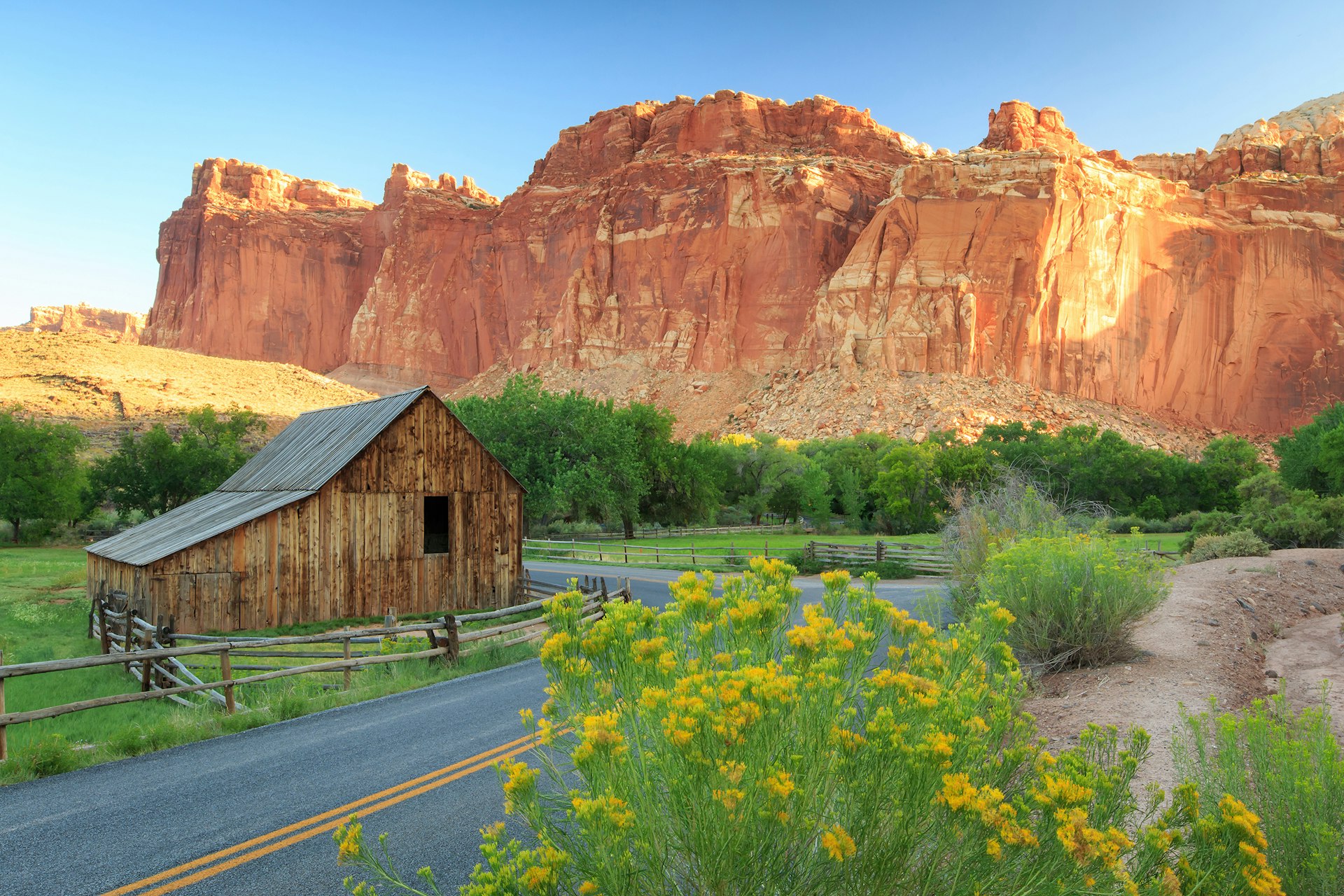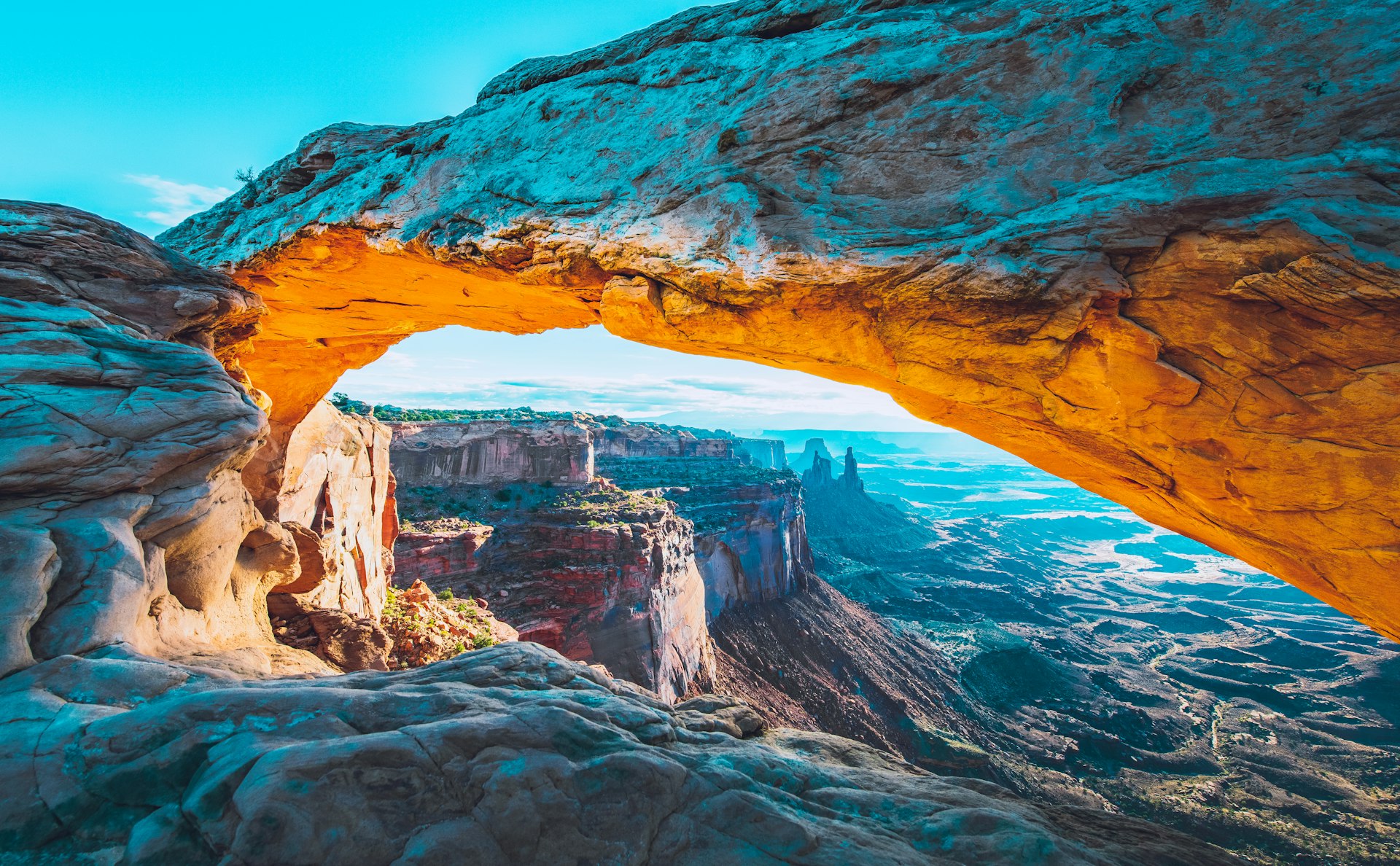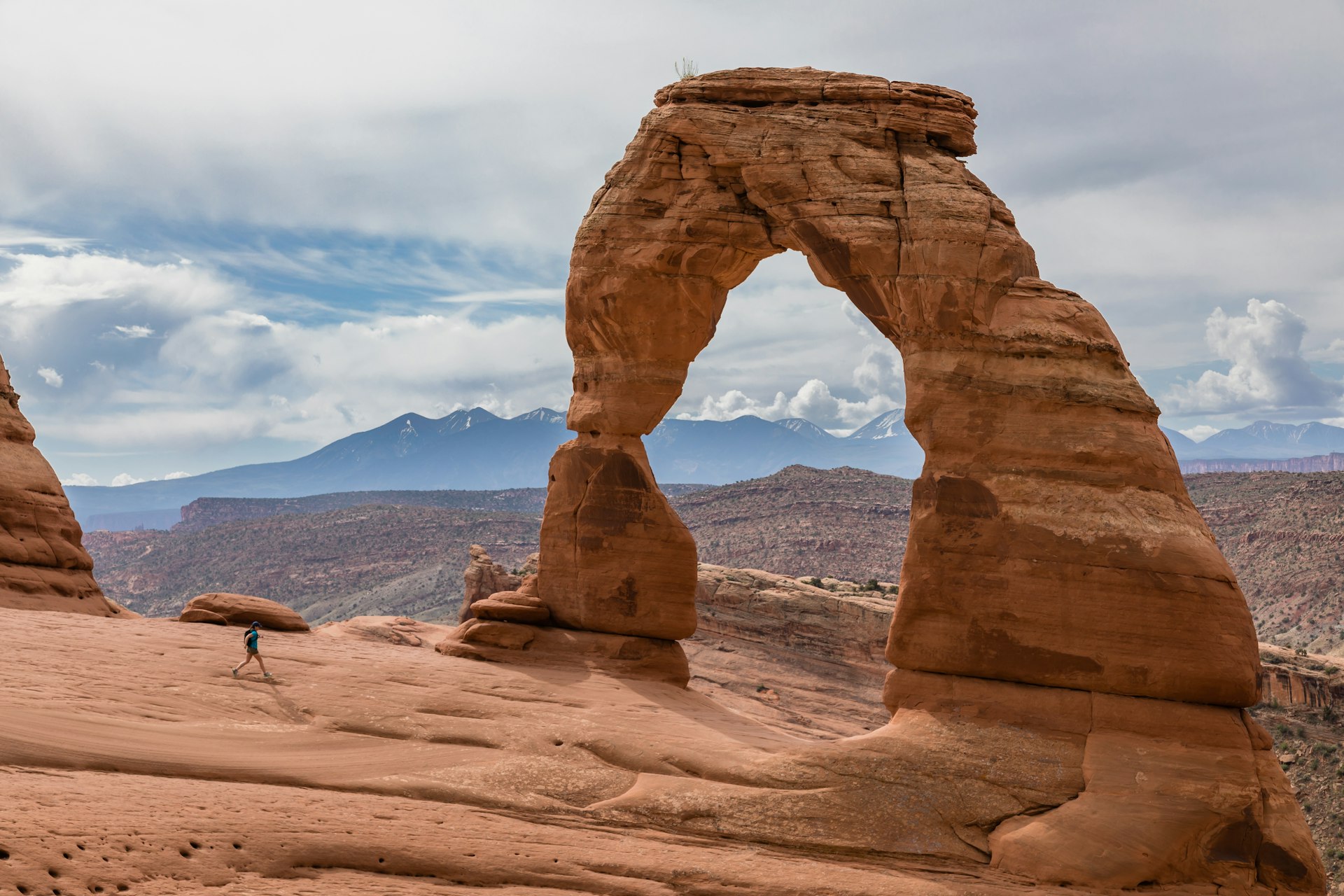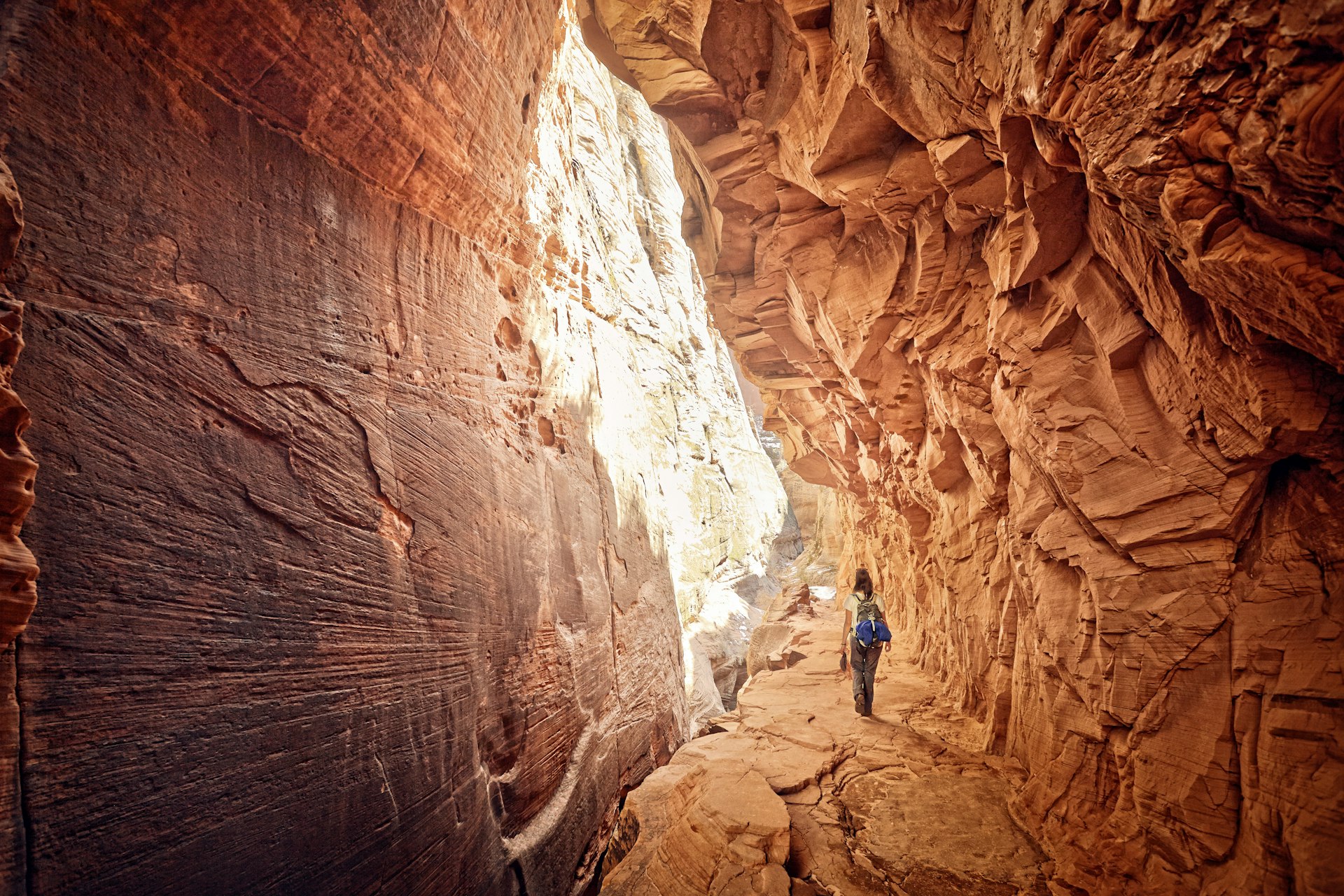Utah might not have the most national parks of any state – that honor goes to California – but it certainly has the highest concentration.
All of Utah’s “Mighty 5” are within easy driving distance of one another, meaning that the state is prime for an epic national parks road trip that you can even squeeze into a short amount of vacation time. With only a week to spare, it’s possible to get to know the distinct personalities of each of the state’s national parks.
Here’s how to plan an unforgettable drive in Utah.
Where should you start a Utah national parks road trip?
You can tackle Utah’s national parks west to east or vice versa, depending on your starting destination. Going from west to east is generally the most popular option because Zion National Park is just a few hours from the international airport in Las Vegas. You could also start this road trip in Salt Lake City, heading for either Zion or Arches first.
Where should I rent a car for a Utah road trip?
If you’re flying in to visit Utah’s national parks, it’s easiest to rent a car at your arrival airport. After picking up the car, head to the grocery store to buy water, snacks and other supplies before you hit the road, especially if you’re looking for something specific. The gateway towns to Utah’s national parks are small, and their stores often don’t have as wide of a selection.
When is the best time to drive between Utah’s national parks?
Late spring and early fall are the best seasons for road tripping in Utah. Summer is a popular time, but that means more cars on the road and more hikers on the trails. Winter is great for solitude seekers, but make sure you have the know-how to drive on snowy roads and a backup plan in case of closures or worse. State highways in some areas might be shut down until May because of heavy snowfall, particularly in the high elevations around Brian Head, north of Zion National Park.
Stop 1: Zion National Park
The vibe: Awesome canyon and iconic hikes
What to do: Zion Canyon is one of the most intriguing natural wonders in the country, and it chalks up the visitor numbers to prove it. See what makes Zion so extraordinary by taking on the national park’s two iconic hikes: Angels Landing (permit required), a chain-assisted white-knuckle climb to a lofty narrow plateau, and the Narrows, where the trail is the Virgin River and you wade through the water as it churns through a towering slot canyon.
What to eat: In the heart of the canyon, the historic Zion Lodge has two places to eat: a small cafe and a full-fledged restaurant. The food isn’t particularly memorable, but the setting certainly is, and it’s the only place to eat inside the national park if you don’t bring your own supplies. Just outside Zion National Park’s south entrance, Zion Canyon Brew Pub was the first microbrewery in southern Utah and serves up pub grub that pairs perfectly with its beers. More restaurants, coffee shops and small grocery stores abound in Springdale, the gateway town hugging Zion’s south entrance.
Where to stay: Zion National Park has two in-park accommodation options: camping or Zion Lodge. You need to book months in advance to get a reservation for either. Springdale has lots of excellent places to stay. See if rooms are available at Under the Eaves Inn, Red Rock Inn or Desert Pearl Inn, or head a bit further from the canyon. In East Zion, Zion Ponderosa Ranch Resort is ideal for families, with tons of activities for all ages. To the west, AutoCamp Zion offers a hip stay in Airstream trailers, and Under Canvas has set up gorgeous luxury glamping tents on Kolob Terrace Road.
The drive (75 miles, 1 hour and 25 minutes): Leave Zion National Park through the east entrance, driving through the tight-squeeze Zion–Mt Carmel Tunnel, which was the longest tunnel in the country when it opened in 1930. Continue on Hwy 9 to Mt Carmel Junction and then head north on Hwy 89. Turn east on Scenic Byway 12, nationally recognized as an “All-American Road” for its history and landscapes. You get a taste of what’s in store at the next national park as you drive through redrock arches and past intriguing rock formations shaped like Crayola crayons – and colored just as brightly.
Want to know more about Zion? Here’s our guide
Stop 2: Bryce Canyon National Park
The vibe: Alien rock formations
What to do: Bryce Canyon hides its treasures from view when you first enter the park, but as soon as you reach the rim of the plateau, an army of rock spires called hoodoos stands at attention in the bowl of the natural amphitheater. The paved road through the national park is sprinkled with scenic overlooks where you can stop and gawp at these mesmerizing formations. Inspiration Point and Rainbow Point are wow-worthy pull-off points. But getting in among the hoodoos is a must. Hike the Navajo Loop from Sunset Point, book a horse ride on Peekaboo Loop or find a quieter collection of hoodoos on the Fairyland Loop.
What to eat: Bryce Canyon is Utah’s only other national park (besides Zion) that has a historic lodge inside the park, which has a restaurant (don’t miss the elk chili). There’s also a park general store that sells pizza, craft beer, ice cream and snacks. Bryce Canyon City is just outside the national park gates, but the restaurants in the small town of Tropic, a short drive to the southeast, are better. Try the pulled pork at IDK Barbecue or have a classy white-tablecloth dinner at Stone Hearth Grille.
Where to stay: Book far in advance to snag a place to sleep inside the park, either a campsite or a room at Bryce Canyon Lodge. Bryce Canyon City has several options near the park entrance, but it’s worth driving a little further to Bryce Glamp & Camp, a scenic, secluded spot where you can watch the night sky from your bed in a bubble dome.
The drive (125 miles, 2 hours and 40 minutes): Continue on Scenic Byway 12, which gets even more beautiful as you crest the rollercoaster hills and sail down the switchbacks. Much of the surrounding land is part of Grand Staircase–Escalante National Monument, which covers nearly 2 million acres. Tempting trailheads beckon, particularly around the towns of Escalante and Boulder – pull over and hike if you have time. Scenic Byway 12 ends at Hwy 24 near Torrey, the gateway town to Capitol Reef National Park.
First time in Bryce Canyon? Here’s what you need to know

Stop 3: Capitol Reef National Park
The vibe: Hikes through history
What to do: Capitol Reef wears its past on its sleeve, and when hiking in this national park, you’re following in the footsteps of many generations past, from the little-understood Native Fremont people to Mormon settlers. Don’t miss the petroglyphs east of the Capitol Reef Visitor Center (accessible via a boardwalk) and on the hike through Capitol Gorge, where ancient Native rock art is carved a short distance from the Pioneer Register, recording the names and dates of 19th-century settlers who passed through this slot canyon. In the center of the park, Fruita was a Mormon settlement established in 1879 and is well known for its orchards, which the National Park Service still maintains. Pick up one of the famous fruit pies from Gifford Homestead, where Fruita’s last inhabitants lived.
What to eat: Torrey is a short drive from the entrance to Capitol Reef National Park, and for such a small town, it has some impressive food options. At Torrey Grill & BBQ, a Culinary Institute of America graduate makes magic with smoked meats, while adorable Wild Rabbit Cafe serves phenomenal all-day breakfasts and sandwiches. Hunt & Gather is a surprising spot for fine dining, showcasing lovingly plated dishes of local ingredients.
Where to stay: Capitol Reef has one developed campground, as well as free primitive sites in the backcountry (free backpacking permit required). If you’d rather stay within four walls, try Torrey Schoolhouse B&B, a 1914 schoolhouse brought back to life as an elegant bed and breakfast. One of the best places to stay in Torrey is Skyview, which has rooms with hot tubs that look out on the redrock scenery, geodesic domes with skylights over the bed for nighttime stargazing, and a rooftop terrace.
The drive (155 miles, 2 hours and 30 minutes): Head east on Hwy 24, called the Capitol Reef Scenic Byway, which turns north at Hanksville. If you have time, detour west of Hwy 24 to Goblin Valley State Park to wander among its bizarre rock formations. On the east side of Hwy 24, Horseshoe Canyon is part of Canyonlands National Park and has one of the most significant Native rock art sites in North America – it’s nicknamed the “Louvre of the Southwest.” The road to Horseshoe Canyon is not paved, and a high-clearance 4WD vehicle is recommended. When Hwy 24 comes to an end near Green River, join Interstate 70 east and carry on until the Moab turnoff at Hwy 191. Turn west on Hwy 313 to reach another area of Canyonlands National Park.
Hanging around in Capitol Reef? Here’s what to do there

Stop 4: Canyonlands National Park: Island in the Sky district
The vibe: Epic views
What to do: Canyonlands is Utah’s largest and least-visited national park. Few travelers venture to its most remote areas (and those who do require suitable vehicles and self-sufficiency), and Canyonlands’ quieter nature can be a welcome break from Utah’s busier parks. It is divided into four districts, the most accessible of which is Island in the Sky, near Moab. This area stretches out atop a majestic mesa thousands of feet above the Colorado and Green Rivers, the powerful forces that sculpted this land into sheer canyons and needle-like pinnacles. The scenic drive through the Island in the Sky district dawdles past a number of overlooks. Get a 360-degree bird’s-eye view of the landscape from the humbly named Grand View Point where the paved road ends.
What to eat: Moab’s main street is lined with great restaurants where you can fuel up for a day out, and the town is just a 40-minute drive from the Island in the Sky Visitor Center. In the northern part of Moab, Proper Brewing has an excellent beer garden where you can kick back and enjoy a burger and a Utah-made brew.
Where to stay: The Island in the Sky district has one campground. More campsites on Bureau of Land Management (BLM) land are scattered along Hwy 313, the main road into the national park, as well as along Hwy 128 and the Colorado River south of Arches National Park. For hotel accommodations, stay in Moab for an easy journey. Field Station is one of our top picks for location, price and adventure-seeking atmosphere, housed in a well-renovated roadside motel.
The drive (29 miles, 40 minutes): Canyonlands and Arches are about as close as two national parks can be, and it’s just a 30-minute drive from the Island in the Sky Visitor Center to Arches Visitor Center. If you can’t get enough of the views, take a detour to Dead Horse Point State Park for even more memorable vistas. Take Hwy 313 to Hwy 191 and drive south for a few miles to the turnoff for Arches National Park.
Want to see even more of Canyonlands? Here’s what you need to know

Stop 5: Arches National Park
The vibe: Arches galore
What to do: The main draw of Arches is right in its name, and nowhere on Earth has more of this type of rock formation than this national park. Delicate Arch is the most iconic, enshrined on Utah’s license plates, and many more can be seen along the park’s main paved road on short hikes and from easy-to-reach viewpoints. At the end of the road, the Devils Garden Trail packs several arches into an easy or adventurous hike, depending on how far you want to go, including 306ft Landscape Arch, one of the longest in the world.
What to eat: There’s nowhere to eat inside Arches National Park, so bring in supplies from Moab or fuel up in town before or after a day of arch admiring. Find a variety of crowd-pleasing, budget-friendly options at Moab Food Truck Park or reserve a table at Desert Bistro, one of the best restaurants in this part of the state, for game and seafood in an 1892 former dance hall.
Where to stay: Arches has one campground inside the park (book far in advance), and campers can also find lots of sites on BLM land just outside the park boundaries. Otherwise, Moab makes for an excellent base camp, with plenty of hotels along its main street and beyond. Secluded south of town, ULUM Moab offers luxury glamping tents with views of its very own arch.
The drive: Round off your Utah national parks road trip by heading back to Salt Lake City (235 miles from Moab) or Las Vegas (460 miles from Moab). The fastest but least interesting way to get to Las Vegas is to take the interstates (I-70 north of Moab and then I-15 south), but if you have time, take the long road south from Moab, stopping at the Needles district of Canyonlands National Park, checking out film-famous Monument Valley on Navajo land and testing your luck by trying to get a permit for the Wave – one of the most sought-after hikes in the Southwest – in Kanab.
Need more info about Arches? Here’s our guide for first-time visitors
Tips for EV drivers
Despite how remote some parts of the state are, Utah is an excellent place for an EV road trip, especially to the national parks. Some campgrounds and many hotels, including Zion Lodge inside the national park, have EV chargers for guests. Tesla has several Superchargers across the state, particularly along I-15 and I-70, including in St George (about 45 miles from Zion National Park’s south entrance), Green River and Moab (close to Arches and Canyonlands National Parks) and Blanding (about 70 miles from Canyonlands’ Needles district).
A tricky stretch for EV drivers is the journey between Capitol Reef National Park and Moab. The Capitol Reef gateway town of Torrey has chargers, as does Green River, but you might need to be careful about how many places you explore in between.
